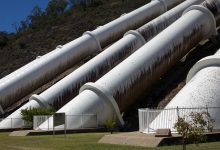On Tuesday, the Australian Financial Review published an article on Snowy Hydro’s 2020 annual report. It quoted Snowy Hydro’s managing director Paul Broad saying that Snowy Hydro’s initial estimated financial return on its Snowy 2.0 pumped hydro project – 8 per cent – “now looks incredibly conservative”.
This optimistic prognosis sits at odds with the latest Snowy 2.0 cost estimate of between $5.7 billion and $6.2 billion (provided to credit rating agency Standard and Poor’s), which is about 50% higher than the estimate on Snowy Hydro’s website ($3.8bn – $4.5bn) and which Snowy Hydro used in its Final Investment Decision.
So, to say that the estimated financial return of Snowy 2.0 “now looks incredibility conservative” must mean that Snowy Hydro expects that it will make very much higher margins than it had originally expected.
To substantiate his more bullish expectation, Broad said that 22% of the pumping at Lake Jindabyne this year has been at negative prices. If Snowy Hydro expects that it will be paid to pump water for Snowy 2.0 and then paid again when it generates electricity from that water, the future could be brighter than first thought, despite the ever-escalating capital spend.
But is this right? We tested the claim that 22% of the pumping at Lake Jindabyne has been at negative prices. The pumping station at Lake Jindabyne is not part of a closed loop pumped hydro system. Instead, it simply pumps water up to the Geehi reservoir, from where it flows through Murray 1 and 2 power stations and thence to the Murray River.
Data on Lake Jindabyne pumping is not publicly available, although the obvious point of comparison is the prices paid when the Tumut 3 Pumped Hydro Station was pumping (Snowy Hydro has the same incentives to pump at Tumut 3 as at Lake Jindabyne i.e. when prices are low).
The publicly available market data shows that prices were negative when Tumut 3 was pumping for just 5 (five) out of the 1,135 half-hour Settlement Periods (i.e. 0.44%) in the 2020 financial year (and the average price in these five half-hours was -$2.60/MWh).
The average price paid when pumping at Tumut 3 over the 2020 financial year was $46/MWh, a little above the 10-year average. If we used the calendar year to-date instead of the financial year we get much the same result.
So how can it be that prices were negative for 22% of the time that Snowy Hydro pumped at Jindabyne, when prices were negative for only 0.44% of the time that it pumped at Tumut 3, or 0.16% of all half-hour settlement periods in the 2020 financial year?
It’s not an idle question. If Snowy Hydro is right about its numbers, it must mean Jindabyne hardly ever pumped. And if that is the case, it begs the question that if this is how Snowy 2.0 is to operate then how can it possibly make any meaningful amount of money?
And why did Snowy Hydro make claims for Jindabyne pumping (whose data is not in the public domain and has nothing to do with pumped hydro), when the obvious point of comparison for Snowy 2.0 would surely be pumping at Tumut 3?
As we have made clear on numerous occasions, even using Snowy Hydro’s Final Investment Decision assumptions (which even Snowy Hydro now disavows), there is absolutely no chance that Snowy 2.0 will cover its costs.
And other aspects of the project continue to become ever gloomier. AEMO expects that – for as far as it has modelled (until 2042) – Snowy 2.0 will generate less than half what Snowy Hydro claims it will.
And Standard and Poor’s has downgraded Snowy Hydro’s stand-alone credit rating (to ‘junk’ status) and suggested the Government will have to inject more equity (than the initial $1.38bn) to protect its credit rating from sliding further into junk territory.
From the outset we urged the Government to get an independent assessment of this project before committing to it. They have not done that and as time passes the evidence continues to mount that this project is a dud. If they were not already concerned, the Prime Minister, Energy Minister, Finance Minister, Treasurer and Snowy Hydro Board ought now to be very concerned, even if only behind closed doors and even if only for their own reputations.
Bruce Mountain is director of the Victoria Energy Policy Centre.










